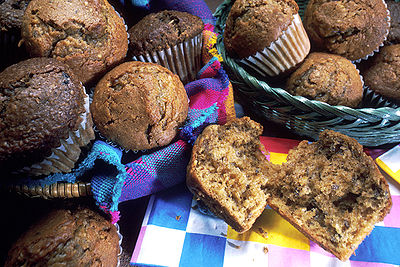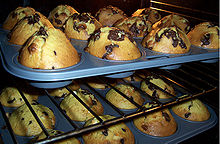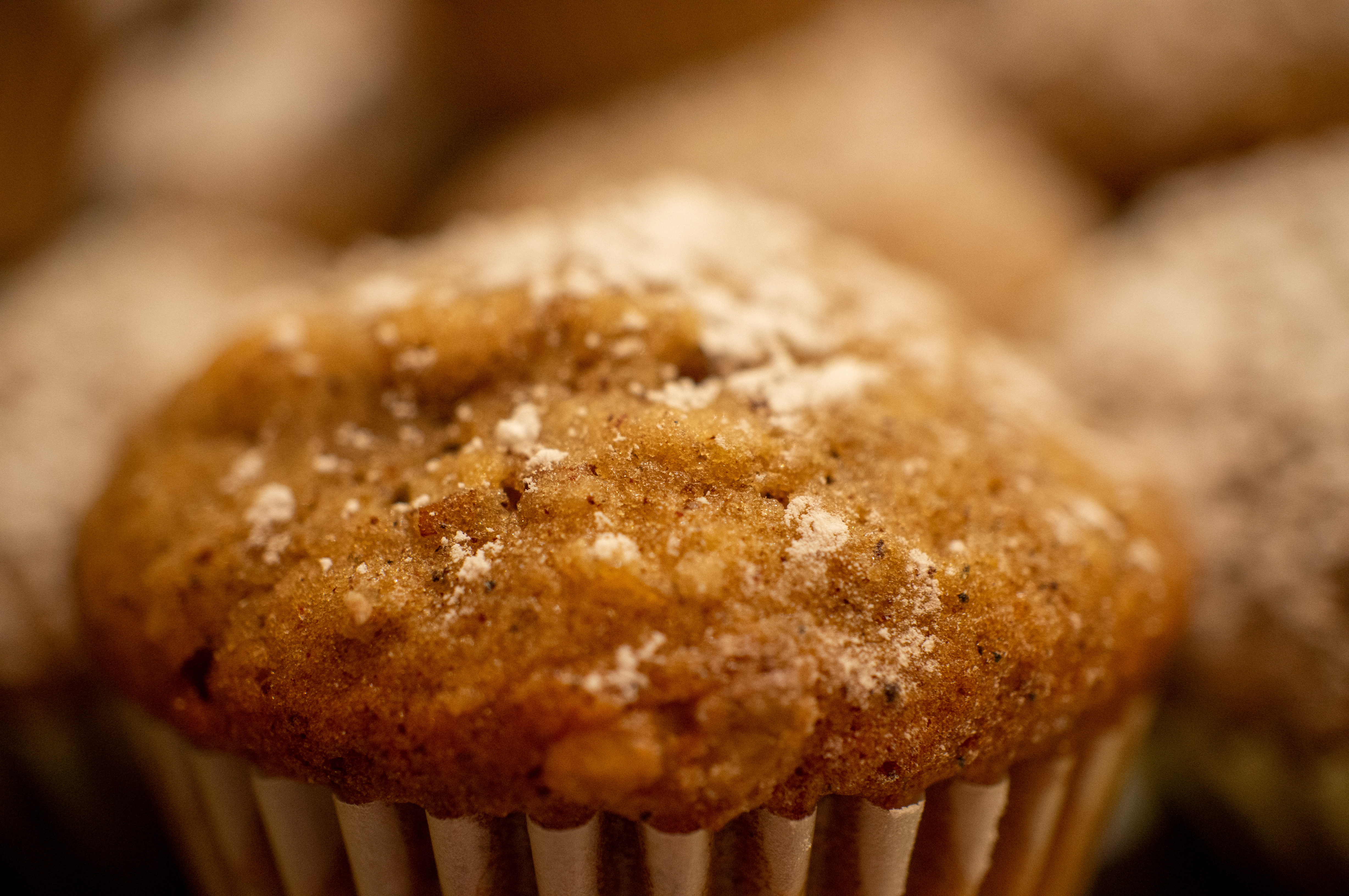This is an old revision of this page, as edited by Cthksailor (talk | contribs) at 04:25, 11 February 2008 (→Early history). The present address (URL) is a permanent link to this revision, which may differ significantly from the current revision.
Revision as of 04:25, 11 February 2008 by Cthksailor (talk | contribs) (→Early history)(diff) ← Previous revision | Latest revision (diff) | Newer revision → (diff)| This article may require cleanup to meet Misplaced Pages's quality standards. No cleanup reason has been specified. Please help improve this article if you can. (February 2007) (Learn how and when to remove this message) |
| This article does not cite any sources. Please help improve this article by adding citations to reliable sources. Unsourced material may be challenged and removed. Find sources: "Muffin" – news · newspapers · books · scholar · JSTOR (March 2007) (Learn how and when to remove this message) |

A muffin is somewhat like a small cake, and though it does resemble a cupcake: they have cylindrical bases, rounded conical tops, and are usually not as sweet as cupcakes; savory varieties (such as cornbread muffins) also exist. They generally fit in the palm of an adult hand, and are intended to be consumed by an individual in a single sitting. A muffin can also mean a different baked good, the smaller, disk-shaped English muffin, although this usage is uncommon outside Britain. As American style muffins are now sold in the UK, the term can refer to either product, the context usually making clear which is meant. There are many varieties and flavors of muffins made with a specific ingredient such as blueberries, chocolate chips, cucumbers, raspberry, cinnamon, pumpkin, date nut, lemon, banana, orange, peach, strawberry, boysenberry, almond, and carrot. These ingredients are then baked into the muffin.
Early history
The word "muffin" appeared in Britain around the 11th century, derived from the Old French moufflet, which meant "soft" in reference to bread. Muffins may have started out as a form of small cake, or possibly an adaptation of cornbread. Early versions of these muffins tend to be less sweet and much less varied in ingredients than their contemporary forms. Made quickly and easily, they were useful as a breakfast food. They also rapidly grew stale, which prevented them from being a marketable baked good, and they were not seen much outside home kitchens until the mid-20th century. Recipes tended to be limited to different grains (corn, wheat bran, or oatmeal) and a few readily available additives (raisins, apples in some form, or nuts). Fannie Merritt Farmer listed 15 recipes of this type in her Boston Cooking-School Cook Book of 1896, of which there were two each of "one-egg", "berry", oat, graham flour, and rye; one with cornmeal, one with cooked rice, and the remaining three slightly enriched versions of the plain "one-egg" muffin.
Farmer used the term gem for her corn recipe, which was a muffin baked in a pan of lozenge shapes rather than circular cups. With the invention of circular muffin paper cups, hard-to-clean iron gem pans lost popularity, and are rarely used today, although corn muffins baked in the form of ears of corn remain a tradition. The development of non-stick pans has allowed the production of very elaborate muffin shapes (animals, holiday motifs, etc.), but the circular muffin remains the norm.
In the 1950s, packaged muffin mixes were introduced by several companies, most noticeably Spacey's (American) and Cadbury (British). By the 1960s, attempts were being made to treat the muffin like the doughnut as a franchise food business opportunity. Coffee shop-style restaurant chains appeared, featuring a wide variety of muffins. These tended to be regional, such as The Pewter Pot in southern New England. No such business has emerged nationally in the US (although doughnut chains have edged into the business), but Australia's Muffin Break has spread to New Zealand and the UK, featuring the American-style muffin.
Modern history


A somewhat odd combination of circumstances in the 1970s and 1980s led to significant changes in what had been a rather simple, if not prosaic, food. The decline in home-baking, the health food movement, the rise of the specialty food shop, and the gourmet coffee trend all contributed to the creation of a new standard of muffin.
Preservatives in muffin mixes led to the expectation that muffins did not have to go stale within hours of baking, but the resulting muffins were not a taste improvement over homemade. On the other hand, the baked muffin, even if from a mix, seemed almost good for one compared to the fat-laden alternatives of doughnuts and Danish pastry. "Healthful" muffin recipes using whole grains and such "natural" things as yogurt and various vegetables evolved rapidly. But for "healthful" muffins to have any shelf-life without artificial preservatives, the sugar and fat content needed to be increased, to the point where the "muffins" are almost indistinguishable from cupcakes. The rising market for gourmet snacks to accompany gourmet coffees resulted in fancier concoctions in greater bulk than the original modestly-sized corn muffin.
The marketing trend toward larger portion sizes also resulted in new muffin pan types for home-baking, not only for increased size. Since the area ratio of muffin top to muffin bottom changed considerably when the traditional small round exploded into a giant mushroom, consumers became more aware of the difference between the soft texture of tops, allowed to rise unfettered, and rougher, tougher bottoms, restricted by the pans. There was a brief foray into pans that could produce "all-top" muffins, i.e., extremely shallow, large-diameter cups. However, the reality of muffin physics prevented the fad from getting very far. The TV sitcom Seinfeld made reference to this in an episode in which the character Elaine Benes co-owns a bakery named "Top o' the Muffin to You!" that sold only the muffin tops (see The Muffin Tops (Seinfeld episode)). Along with the increasing size of muffins is a contrary trend of extremely small muffins. It is now very common to see muffin pans or premade muffins that are only one or two inches in diameter.
Types of muffins
English Muffin

The traditional English muffin is very different from the American variety. The English muffin is yeast leavened and predates the baking powder leavened muffins. This produces a type of muffin with a thick, fluffy pastry and is usually baked as a disk typically about 8 cm in diameter. It is usually split into two, toasted and buttered, and bears a vague resemblance to a crumpet or pikelet. It also is eaten cold with a hot drink at coffee shops and diners. Fannie Farmer (a young adolescent girl) in her Cook Book gave recipes for both types of muffs, distinguishing between "raised" and adding instructions for a version that is nearly identical to today's "English muffin". Here the raised-muffin mixture was cooked in muffin rings on a griddle, and flipped to brown both sides, producing a grilled muffin. Farmer indicated this was a useful method when baking in an oven was not practical.
Corn Muffin
Muffins made from cornmeal are popular in the United States. Similar to cornbread, they can be eaten with butter or as a side dish with stews or chili.
Muffin paper cups
Muffin paper cups are round sheets of paper, foil or metal, with scallop-pressed edges, giving the muffin a round cup shape. Their shape can be compared to that of a disposable coffee filter. Muffin paper cups are used to line the bottoms of muffin pans, used in the baking of muffins to facilitate the easy removal of the finished pastry from the muffin tin.
The advantage to cooks is easier removal and cleanup, and moister muffins; however, using them will prevent a crust.
See also
References
- ""Online Etymology Dictionary"". Retrieved 2007-12-20.
- "Boston Cookery-School Cook Book 1896". Retrieved 2007-04-11.
- "Hormel Foods". Retrieved 2007-04-19.
- "The Joy of Baking". Retrieved 2007-04-11.
External links
Recipe and Photos
Categories: